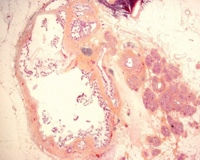Can an Intraductal Papillary Mucinous Tumor be a Potential Indicator of Concurrent Adenocarcinoma of the Pancreas?
Abstract
Context Despite the recent progress of diagnostic and therapeutic modalities, survival rates of pancreatic adenocarcinoma remain poor, mainly due to late diagnosis. Case report We report the case of a 56-year-old man who was diagnosed with a symptomatic intraductal papillary mucinous tumor of the pancreas located in the uncus. This tumor was associated with a concurrent stenosis of the isthmic pancreatic duct which resulted in a distal dilation. A Whipple procedure was performed. During the procedure, a concomitant adenocarcinoma was diagnosed 2 cm from the primary intraductal papillary mucinous tumor, causing the isthmic stenosis. A second resection was then performed to the left of the pancreatic isthmus, and adjuvant chemotherapy was performed. The patient is well and without any sign of recurrence 7 months after surgery. Conclusion We discuss the possibility that intraductal papillary mucinous tumors may be a "red flag" enabling earlier diagnosis of a concurrent pancreatic adenocarcinoma arising in another area of the pancreas.
Image: Pancreatic ducts lined by tall, columnar, mucin-containing epithelium with papillary projections.
Downloads
References
Sohn TA, Yeo CJ, Cameron JL, Iacobuzio-Donahue CA, Hruban RH, Lillemoe KD. Intraductal papillary mucinous neoplasms of the pancreas: an increasingly recognized clinicopathologic entity. Ann Surg 2001; 234:313-22. [PMID 11524584] (FULL TEXT: http://journals.lww.com/annalsofsurgery/pages/articleviewer.aspx?year=2001&issue=09000&article=00005&type=abstract)
Kloppel G, Solcia E, Longnecker D, Capella C, Sobin LH, editors. Histological typing of tumours of the exocrine pancreas. WHO International Histological Classification of Tumours. 2nd ed. Berlin: Springer; 1996.
Cho KR, Vogelstein B. Genetic alterations in the adenoma-carcinoma sequence. Cancer 1992; 70:1727-31. [PMID 1516027] (FULL TEXT: http://www3.interscience.wiley.com/cgi-bin/fulltext/112675404/PDFSTART)
Wilentz RE, Hruban RH. Pathology of cancer of the pancreas. Surg Oncol Clin North Am 1998; 7:43-65. [PMID 9443986]
Terris B, Ponsot P, Paye F, Hammel P, Sauvanet A, Molas G, et al. Intraductal papillary mucinous tumors of the pancreas confined to secondary ducts show less aggressive pathologic features as compared with those involving the main pancreatic duct. Am J Surg Pathol 2000; 24:1372-7. [PMID 11023098] (FULL TEXT: http://journals.lww.com/ajsp/pages/articleviewer.aspx?year=2000&issue=10000&article=00006&type=abstract)
Fukushima N, Mukai K, Sakamoto M, Hasebe T, Shimada K, Kosuge T, et al. Invasive carcinoma derived from intraductal papillary-mucinous carcinoma of the pancreas: clinicopathologic and immunohistochemical study of eight cases. Virchows Arch 2001; 439:6-13. [PMID 11499841] (FULL TEXT: http://www.springerlink.com/content/tceenp7ahcwn5ktv/fulltext.html)
Yamaguchi K, Ohuchida J, Ohtsuka T, Nakano K, Tanaka M. Intraductal papillary-mucinous tumor of the pancreas concomitant with ductal carcinoma of the pancreas. Pancreatology 2002; 211:484-90. [PMID 12378117] (FULL TEXT: http://content.karger.com/ProdukteDB/produkte.asp?Aktion=ShowPDF&ArtikelNr=64716&Ausgabe=228570&ProduktNr=224334&filename=64716.pdf)
Kuroki T, Tajima Y, Tsuneoka N, Adachi T, Kanematsu T. Combined pancreatic resection and pancreatic duct-navigation surgery for multiple lesions of the pancreas: intraductal papillary mucinous neoplasm of the pancreas concomitant with ductal carcinoma of the pancreas. Hepatogastroenterology 2008; 55:1830-3. [PMID 19102402]

Copyright (c) 2010 Julien Jarry, Genevieve Belleannee, Alexandre Rault, Antonio Sa Cunha, Denis Collet

This work is licensed under a Creative Commons Attribution 4.0 International License.
As a member of Publisher International Linking Association, PILA, iMedPub Group’s JOP follows the Creative Commons Attribution License and Scholars Open Access publishing policies. Journal of the Pancreas is the Council Contributor Member of Council of Science Editors (CSE) and following the CSE slogan Education, Ethics, and Evidence for Editors.